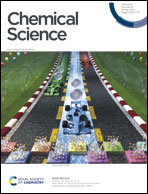Highly selective generation of singlet oxygen from dioxygen with atomically dispersed catalysts†
Abstract
Singlet oxygen (1O2) as an excited electronic state of O2 plays a significant role in ubiquitous oxidative processes from enzymatic oxidative metabolism to industrial catalytic oxidation. Generally, 1O2 can be produced through thermal reactions or the photosensitization process; however, highly selective generation of 1O2 from O2 without photosensitization has never been reported. Here, we find that single-atom catalysts (SACs) with atomically dispersed MN4 sites on hollow N-doped carbon (M1/HNC SACs, M = Fe, Co, Cu, Ni) can selectively activate O2 into 1O2 without photosensitization, of which the Fe1/HNC SAC shows an ultrahigh single-site kinetic value of 3.30 × 1010 min−1 mol−1, representing top-level catalytic activity among known catalysts. Theoretical calculations suggest that different charge transfer from MN4 sites to chemisorbed O2 leads to the spin-flip process and spin reduction of O2 with different degrees. The superior capacity for highly selective 1O2 generation enables the Fe1/HNC SAC as an efficient non-radiative therapeutic agent for in vivo inhibition of tumor cell proliferation.



 Please wait while we load your content...
Please wait while we load your content...